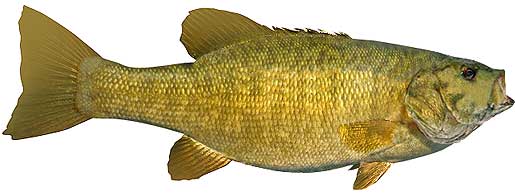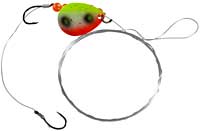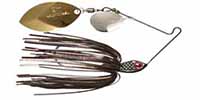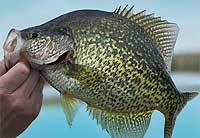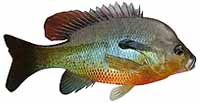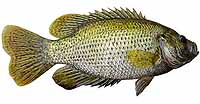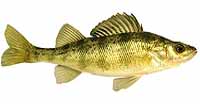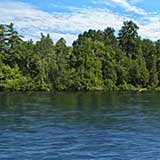Fishing Report For Great Sacandaga Lake, NY
By Rick Seaman
September 22, 2025
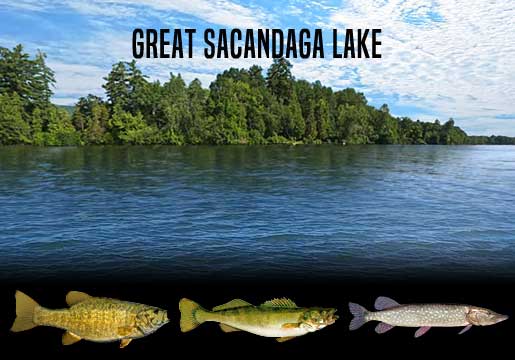
Fishing Reports
Popular Fish Species Great Sacandaga Lake, NY
Smallmouth Bass
Current Report: Good To Very Good
FALL. As Fall arrives, smallmouth here follow schools of baitfish into coves and bays 5 to 10 feet deep. This is where jerkbaits, crankbaits, and slow-rolled spinnerbaits, are quite successful. The average fish being caught averages about 1 1/4 pounds, but plenty of 3 pound smallies are also caught. Fishing shallow for smallmouth is often good on cold, windy, cloudy and rainy days.
WINTER. In Winter the lake freezes over, which will isolate them around deeper structure, points and creek channels, often suspending in open water above these features. They can generally be found from 20 to 40 feet deep. Here they hold, feeding less frequently, awaiting warmer water to return in Spring.
SPRING. When water temperatures rises into the 50's, smallmouth move from deep wintering spots to shallower water, outside spawning areas. They feeding heavily in 5 to 15 feet of water at this time, and are typically caught on jerkbaits, crankbaits, tube baits, Ned rigs, and crayfish imitating plastics. Once water warms into the high 50's, they move into shallower water, and create nests in gravel or sand areas, then lay their eggs. Females then move to deeper water and males remain to guard the eggs, and then the fry. After a couple weeks, the males also move to 10 to 15 feet deep, and feed aggressively. Crankbaits, tube baits, Ned rigs, plastic worms, spoons and swimbaits are catching smallies during this period.
SUMMER. Smallmouth bass, including a few trophy-size gems, are currently feeding shallow early and late in the day, where they are being caught on topwater, crankbaits, swimbaits, Ned rigs and tube baits. Smallmouth bass here feed on crawfish, threadfin shad, gizzard shad, and small sunfish. They prefer rocky or gravel bottom areas, as this is where crayfish live. During the hotter parts of the day, they are being caught on points, humps, and ledges 15 to 30 feet deep. Often these deeper fish are part of a school of smallmouth.
Walleye
Current Report: Good To Very Good
Spring and Fall are the best seasons for catching walleye, as they spend more time in shallower water.
FALL. Fall brings cooler temperatures to shallow water, drawing walleye and baitfish shallower. Jigs, swimbaits, spoons, crankbaits, jerkbaits, and spinnerbaits are all historically good for catching walleye this time of year. Early Fall finds them in 10 to 20 feet of water. Later in Fall, they move out deeper again. Dragging jigs or worm harnesses with nightcrawlers or leeches, or bottom bouncers, around ledge drop-offs is popular. Watch for the bigger walleye to be slightly deeper than the majority of the school.
WINTER. This Winter fishing for walleye was pretty good through the ice. Before, during and after the ice, anglers report catching them in 25 to 40 feet of water, along creek channel edges, rocky humps and ledges. They primarily feed on small fish, staying close to the bottom. After ice-out blade baits, jigs tipped with minnows, swimbaits, spoons, deep-diving crankbaits, and worm harness spinners, are all working while slow trolling or drift fishing.
SPRING. Early Spring brings warming water in the shallows, and draws walleye here to feed, especially rocky areas and inlet channels. Here, in 8 to 15 feet deep, they will spawn once the water warms to the mid to high 40's. When they move shallow, bright colored jigs, tipped with minnows or nightcrawlers typically attracts bites. Spinnerbaits, jerkbaits and crankbaits are also working when walleye are up shallow. Afterwards, they move to 15 to 25 feet deep around shallow points, flats, shoals and ledges, nearby shore, often staying in close proximity to their spawning locations.
SUMMER. Water temperatures rise in Summer, and walleye fishing is good if you can get your bait deep enough. Walleye tend to concentrate in 15 to 30 feet of water, preferring the cooler temperatures. Throughout Summer, early in the morning, and from dusk to long after dark are good times to catch walleye. At those times they move slightly shallower to feed in low-light conditions. Night fishing is often good in Summer, as well. The rest of the time they are cruising flats and creek channel edges, where they are harder to locate. When the bite is slow, grubs and nightcrawlers, fished just off the bottom are catching walleye.
Northern Pike
Current Report: Good
FALL. As the weather starts turning cold, water temperatures cool fastest in the shallows. This brings baitfish and sunfish into shallower waters, and northerns follow this food source. They hang around weedbed edges, main-lake points, reefs, and rocky shorelines to ambush prey. This is a prime feeding time as they prepare for winter. It is also a good time to catch a trophy in the 20-plus pounds class..
WINTER. Pike remain active in Winter, often congregating in or near remaining weedbeds, especially along the edges. Other structure options include long points, reefs, ledge drop-offs, and rocky humps, ideally nearby deeper water. Ice fishing was good here in winter. At times, when oxygen is depleted in deeper water, northerns suspend directly under the ice, where maximum oxygen is available. Other times they hold on structure in 15 to 25 feet of water, sometimes deeper.
SPRING. After ice out, northern pike migrate to shallow, warmer pockets, bays and coves. Most are caught in 5 to 10 feet of water, often shallower. Once water temperatures reach around 40 degrees, they move into even shallower areas with vegetation, to spawn. After spawning they linger in the shallow bays for a short period. Once water temperatures rise into the 50's, they move to deeper weedbeds and shallow structures adjacent to even deeper water. Bright colors, whites and flashy lures appeal to these predators. Noisy topwater lures can also produce some spectacular strikes. Alternate between baits until you identify which one triggers the most bites for the day.
SUMMER. Northern pike scatter all around the lake, rather than gather in groups. This makes them difficult to locate. During the day they are holding from 10 to 20 feet deep, on ledges, reefs, weedbeds, rock piles, islands and channel edges. Some of the larger specimens are suspending in open water, just outside feeding areas. Trolling or drift fishing produces some nice catches, using spoons, big spinners, cut bait, and deep diving crankbaits. Early and late in the day, they move shallow to feed and can be caught around most weedy shorelines. Noisy topwater lures, spinnerbaits and Johnson spoons with curly-tail grubs, are catching nice pike shallow.
Fishing Video
Fish species to fish for...
Guide to fishing for largemouth bass, smallmouth bass, channel catfish, black crappie, walleye, rainbow trout, brown trout, redbreast sunfish, rock bass, yellow perch and northern pike at Great Sacandaga Lake in New York.
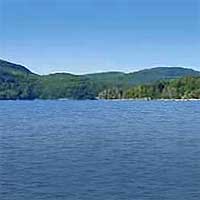
Great Sacandaga Lake is a 27,000-acre lake with 125 miles of shoreline. The lake offers a fishing for northern pike, walleye, smallmouth bass, largemouth bass, yellow perch, and panfish, plus the lake is stocked with trout. There are plenty of options for fishing from the bank. Ice fishing is popular in Winter.
Primary fish species to catch
Click images for fishing tips and details about each species.
Today's Weather & Forecast
Fishing Boat Rentals
Click here for fishing boat rentals.
Public Boat Launch Ramps & Landings
Click here for boat ramps.
Marinas
Click here for marinas.
Fishing License
Click here for a New York Fishing License.
Map - Fishing & Access
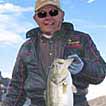
Rick Seaman is a fishing enthusiast with over five decades of fishing experience, a retired tournament fisherman, author of numerous published articles on fishing, and co-author of the book "Bass Fishing - It's not WHAT you throw, It's WHERE you throw it".
Contact Information
Griffis Road Marina
412 Griffis Road
Gloversville, New York 12078
518 883-7009
Fishing lakes in each state
092225
Great Sacandaga Lake, NY Report
NEW YORK


Fishing for rainbow trout, walleye, northern pike and smallmouth bass in east-central NY.


